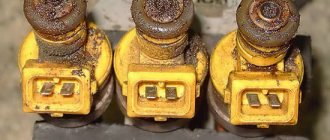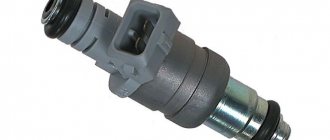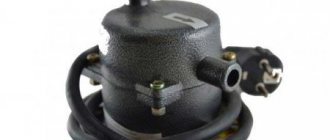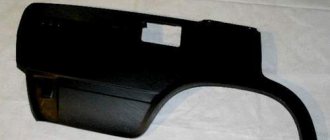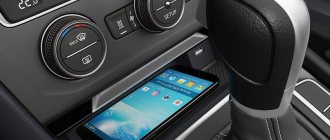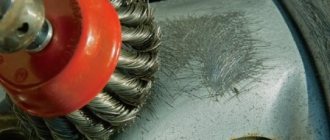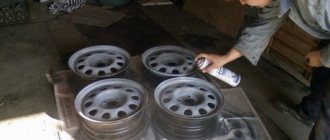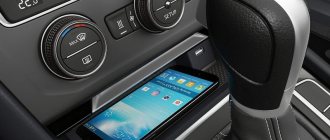23.10.2019
| (Votes: 3, Rating: 4.33) |
Issues discussed in the material:
- What is a throttle valve and how does it work?
- What are the causes and symptoms of a clogged throttle body?
- How to clean the throttle valve yourself
- How to “train” the throttle valve after cleaning
The throttle valve is one of the most important elements of a car. Although its size is small, its role - regulating the flow of air into the intake manifold - is of paramount importance. Long-term operation of a vehicle in Russian climatic conditions significantly increases the risk of damage to this element. Regular cleaning of the throttle valve from carbon deposits and other contaminants will help minimize unpleasant consequences. Otherwise, you need to be prepared for loss of engine power, ignition problems and other troubles.
What is a throttle valve and how does it work?
The throttle valve, located between the intake manifold and the air filter, is one of the most important elements of a car's engine intake system. Despite the lack of need for this part for diesel cars, it is installed on them in case of engine malfunctions. Gasoline engines equipped with a valve lift control system also do not require a throttle valve, however, most often it is installed.
The task of this element is to supply and regulate the air flow that forms the air-fuel mixture. That is, the correct functioning of the valve affects how stable the engine will operate, how fuel will be consumed and how the car will function as a whole.
The throttle valve is essentially a bypass valve. When it is open, pressure equal to atmospheric pressure is maintained in the intake system. When the plug is closed, the pressure drops, approaching the vacuum value (since the engine functions as a pump). This is the reason for the connection between the brake booster and the intake manifold. Structurally, the damper is a round plate that rotates 90°. During one revolution, a cycle occurs from full opening to full closing of the valve.
The throttle valve block (module) consists of the following elements:
- Housings with pipes that are connected to ventilation systems, collecting fuel vapors and coolant (used to heat the element).
- An actuator that, when the gas pedal is pressed, moves the valve.
- Position sensors (potentiometers) that measure the valve opening angle and transmit a signal to the engine control unit. Modern systems are equipped with two sensors that monitor the position of the throttle valve. They can have sliding contact (potentiometers) or be magnetoresistive (non-contact).
- An idle speed regulator that maintains the required crankshaft speed when the element is closed. It provides a minimum throttle opening angle when the gas pedal is released.
How to clean the throttle valve
There are a number of special products designed to clean the surface of the throttle valve. Some craftsmen use WD-40, acetone, solvents and other similar compounds for this. In principle, they can be used, but the risk of damaging something inside the engine increases. Today, car dealerships sell a large number of special products for carrying out this procedure. All of them are relatively inexpensive. Therefore, taking into account the fact that the throttle valve does not need to be cleaned so often, any car owner is able to purchase such a product.
| Name of the product | Description | average price | Notes |
| LIQUI MOLY DrosselKlappen-Reiniger (LM-5111) | The best throttle body cleaner available today. Cleans dirt and oil deposits efficiently. | 520 rub. | Aerosol, volume 400 ml in a cylinder. |
| Mannol Carburetor Cleaner | It cleans oil and dirt well from the valve. It costs less than ABRO, and the cylinder has a larger volume. | 115 rub. | Aerosol, volume 400 ml in a cylinder. |
| ABRO Carb&Choke Cleaner (CC-220) | High quality cleaner. Popular with car owners in our country. | 200 rub. | Aerosol, volume 220 ml in a cylinder. |
The cost is indicated as of prices for summer 2021 for Moscow and the region
Types of throttle valves
Three types of throttle valves are produced. They can have a mechanical drive, be electromechanical and electronic. They were created and developed in the above order. Each variety has its own design features. As it improved, the knot became simpler rather than more complex, but certain nuances appeared.
- Mechanical damper.
As soon as the fuel injection system appeared on cars, they began to be equipped with mechanically driven throttle valves. The unit differs in that the driver needs to control it independently. For this, a cable drive is used, which connects the gas pedal to the gas sector aligned with the valve axis.Structurally, the unit is similar to the carburetor system, the only difference is that the damper is a separate element. The unit is supplemented with a position sensor (determining the opening angle of the valve), an idle speed regulator, bypass channels, and a heating system. The valve position sensor is an element of all types of units. It determines the opening angle, thanks to which the electronic injector control unit understands how much air should be supplied to the combustion chambers and adjusts the flow of fuel.
The system was originally equipped with a potentiometric sensor, which used a change in resistance to measure the opening angle. Currently, more reliable magnetoresistive sensors are used. The reliability of this type of device is explained by the absence of contact pairs, which wear out over time.
Mechanical throttles are equipped with idle speed regulators, which are separate channels that bypass the main one. Adjustment of the air supply, depending on the operating conditions of the power unit, is carried out by an electric valve. It functions as follows - at idle the throttle is closed, but since the engine cannot operate without air, it enters through a separate channel. The task of the control unit is to determine the crankshaft speed, which allows you to adjust the degree of opening of the channel solenoid valve that maintains the required speed.
The principle of operation of bypass channels is similar to the principle of operation of the regulator. However, they serve to maintain engine speed in the event of a load at idle. For example, if you turn on the climate system, the engine is subjected to increased load, which leads to a drop in speed. If the regulator is unable to provide the power plant with the required amount of air, the bypass channels are used. They have a significant drawback - due to their small cross-section, there is a high probability of clogging and icing. To avoid the latter, the throttle valve is connected to the cooling system. Cooling liquid passes through the channels located inside the housing, the task of which is to warm them up.
The disadvantage of the mechanical unit is the existing error allowed in the process of preparing the air-fuel mixture, which affects the engine efficiency and final power. This occurs because the control unit does not control the damper, but only receives information regarding its opening angle. In this regard, if the throttle position was suddenly changed, the ECU may not have time to orient itself to the changed conditions and lead to increased fuel consumption.
- Electromechanical throttle valve.
With the development of technology, the mechanical damper was replaced by an electromechanical one. It was still controlled by a cable. However, its design did not provide for additional channels. But the unit was supplemented with an electronic mechanism for partial control of the valve, the operation of which was regulated by the control unit.The design of the unit consists of an electric motor with a gearbox connected to the damper axis. The operation of the unit is carried out as follows: after the engine is started, the control unit calculates the required amount of air, and the damper opens to a certain angle. Such a control unit can regulate the operation of the power unit at idle. Other engine operating modes still require driver control of the valve.
We recommend
“Throttle sensor malfunctions: we understand the device and diagnostic methods” More details
Thanks to the partial control mechanism, the design of the unit has been simplified, but the main drawback - the error in mixture formation - remains. It is only absent when the engine is idling. - Electronic damper.
Modern cars are increasingly equipped with electronic throttle valves. In them, the gas pedal and the damper axis do not directly interact with each other. The valve is controlled automatically. The design also consists of an electric motor with a gearbox, which is connected to an electronically controlled axis. However, the ECU controls the throttle in all engine operating modes. The unit is supplemented with a gas pedal position sensor.During operation, the ECU uses data transmitted by throttle position sensors, gas pedal, automatic transmission, brake and climate control systems, and cruise control.
The valve opening angle is set based on received and processed information. The intake system is completely under the control of the ECU. Thus, the problem with the error in mixture formation has been solved. The required amount of air will flow regardless of the engine operating mode.
However, such a system also has certain disadvantages, and even more so than the previous two. First, an electric motor is used to open the valve. If a drive malfunction occurs, the unit begins to operate incorrectly, which leads to deficiencies in the functioning of the power unit.
Secondly, insufficiently developed software leads to delays in throttle operation (this point is especially relevant for budget cars). The disadvantage is that after the gas pedal is pressed, the ECU does not collect and process information immediately, but after some time, and only then signals the electric motor that controls the throttle. Usually this is not noticeable, but in some cases it can cause negative consequences.
For example, when starting to move on a slippery surface, it is necessary to quickly switch the engine operating mode, which means it is important that the engine responds to the driver’s actions as quickly as possible. However, due to the delayed reaction, driving the car becomes more difficult, since the driver cannot “feel” the power unit.
Some car owners note another drawback of the electronic damper, which lies in certain factory settings for the operation of the unit. The ECU prevents wheel slipping when starting to move, which in some cases has a negative value.
Premium cars have normal software installed that eliminates response delays. In addition, it is possible to change the engine operating mode depending on preferences. For example, when the “sport” mode is turned on, it reconfigures the functioning of the intake system; when starting to move, the ECU does not affect the power plant, so you can quickly move off.
Self-cleaning the throttle valve in a car
The driving performance of a car depends on the condition of the main components, including the engine. The power unit is a complex structure in which each element must work properly. A very important system in the engine is the throttle valve. This is a valve on the metal surface of which deposits may appear during operation. Because of this, the motor cannot function normally. The main signs of such a problem are decreased dynamics, problems maintaining idle speed, and errors in the control unit. Therefore, it is important to clean the throttle valve in a timely manner. Let's see if you can handle this procedure yourself.
When hard deposits form on the throttle body, it can prevent the optimum fuel to air ratio.
Throttle valve design. The power unit of a vehicle needs a throttle valve to ensure that the required amount of oxygen enters the engine. In addition, this element determines the dynamics and complete combustion of fuel. Not only air, which is purified by the filter, but also crankcase gases, which contain suspended oil, can pass through the damper. Some particulate matter that does not burn in the engine begins to settle on the throttle valve. This negatively affects air permeability and the overall dynamics of the vehicle.
When hard deposits form on the throttle body, it can prevent the engine from producing the optimal fuel to air ratio. As a result, the control unit is forced to switch to a rich or lean mixture, which again affects the performance of the engine. Such a breakdown is often accompanied by floating speed. The fact is that the damper cannot be locked in the correct position, which is why the engine begins to stall and is unable to idle.
On older engines, the throttle position is determined by a small cable that comes to the engine from the gas pedal
Cleaning . On most engines, you can clean the throttle body yourself. This procedure is acceptable for cars that were produced in the 1990s and the first half of the 2000s. If we consider modern power units, it will not be possible to gain access to this valve. If the damper is heavily soiled, you will have to contact specialists and carry out complex repairs.
On older engines, the throttle position is determined by a small cable that runs to the engine from the gas pedal. Therefore, you can disassemble the structure yourself and wash the damper yourself. If your car is equipped with an electronic throttle valve, you will have to calibrate the valve immediately after flushing. This will require special equipment. This drawback seriously limits the possibilities of independent service and repair of the power unit.
To remove all contaminants from the element, you need to use a special liquid for cleaning carburetors
To clean the throttle valve, you need to remove the air filter, which is secured in the structure with metal clamps. There is a throttle behind the filter; it can be installed in a horizontal or vertical position. To remove all contaminants from the element, you need to use a special liquid for cleaning carburetors. As a rule, this composition is in a can, so it is convenient to store it in a car. It is sprayed onto a metal shutter and then operated for about 15 seconds. After this, the surface can be gently wiped with a rag. If liquid remains on the surface, it will subsequently burn inside the motor.
Not everyone knows, but the damper should be cleaned not only outside, but also inside. You can use a rag and cleaner for this. The procedure must be carried out with rubber gloves - carefully lift the damper and wipe its inside. After the procedure, all you have to do is wait a few minutes and wipe the surface again with a clean, dry cloth. At the final stage, the unit is assembled.
Bottom line . During the operation of the vehicle, the throttle valve in the engine gradually becomes dirty. This can have a negative impact on vehicle performance and fuel consumption. Owners of old cars have the opportunity to clean the damper themselves.
Causes and symptoms of throttle valve contamination
Over time, the throttle valve becomes dirty, and it is impossible to prevent this process. The reasons for the appearance of carbon deposits on its walls and on the assembly itself are:
- Oil sedimentation with inclusions of combustion product particles entering the throttle due to crankcase ventilation, which reduces the toxicity of exhaust gases.
- Poor performance of the air filter. If the filter cannot cope with dust, it settles on a layer of oil with combustion products.
A large amount of deposits prevents the throttle valve from functioning normally. Due to dirt, turbulence occurs when air is supplied, reducing its volume, which is assumed by the ECU. In addition, deposits prevent the damper from closing completely, allowing excess air inside.
The symptoms of throttle malfunctions have common symptoms, but problems are not always caused by carbon deposits on the unit. The issue could be the throttle sensor, drive failures, etc. Among the main signs of contamination of the unit are:
- Interruptions in engine operation at idle (stalls, speed is unstable).
- If the speed does not exceed 20 km/h, when you press the gas, the car begins to twitch.
- The engine is difficult to start.
When checking the throttle, it is necessary to evaluate the condition of the valve, even if it is not the cause of the malfunction. It is better to clean the throttle valve in advance, then you will not have to worry about deposits that negatively affect the operation of the engine.
Do-it-yourself throttle valve cleaning
You can clean the throttle valve yourself using automotive tools, a special cleaning agent (for example, for cleaning a carburetor), or a soft cloth. Let's talk about this process using a Nissan car as an example. The procedure will be as follows:
- It is necessary to open the hood and remove the battery terminals.
- Unscrew the clamps of the air filter pipe.
- Disconnect the plugs from the throttle assembly and remove the ventilation hose.
- Remove the air filter receiver in connection with the pipe.
- Using a 5mm hex wrench, unscrew the four fasteners holding the throttle body in place.
- Remove the throttle. This must be done very carefully, reducing the likelihood of damage to the gasket.
- Clean the throttle valve, removing accumulated dirt and soot deposits from it.
- Take the “Carbcleaner” cleaner intended for cleaning carburetors, put a tube on the bottle, and spray the composition onto the surface of the valve. If there is a small layer of dirt, it will dissolve under the influence of the cleaning agent.
- It is necessary to spray the cleaning agent alternately on each side of the mechanism.
- Next, you should wait for the liquid to dry and absorb it into the layer of deposits.
- Then you need to repeat the process of applying the cleaning agent, after which, using a rag, wipe the damper.
- It is also important to clean the inside of the intake manifold where it connects to the throttle body. If there is a small layer of deposits, you can not spray the cleaning agent, but moisten a rag in the liquid and wipe the surface with it.
- After cleaning is completed, it is necessary to return the unit to its place, connecting it to the air pipe.
Now you need to start the car. However, when high speeds appear after cleaning the throttle valve, adaptation of the unit is required.
Adjusting the throttle after cleaning
In some cars, after cleaning the throttle assembly, it may need to be adjusted. This process depends on what type of control valve is installed in the vehicle.
Mechanical throttle control system.
After cleaning the mechanically controlled mechanism, it is necessary to adjust the idle speed control.
This is done as follows:
- The terminals are removed from the battery.
- After 15 minutes they return to their place, the engine starts. The car should be idled for 10 minutes. It is very important that no additional consumer appliances operate during this period.
- After 10 minutes, the power unit must be turned off and, after waiting 10 seconds, restarted.
- Then you need to wait until the engine warms up to operating temperature. Now the car can be used again.
After cleaning the throttle body and adjusting the mechanical control system of the unit, you may need to drive about 150-200 km before the idle speed returns to normal.
We recommend
“How to remove jerking and vibration (upgrading the throttle assembly)” Read more
Electric throttle control system .
After cleaning the device with the electric throttle system, it also needs to be adjusted. The setup is performed as follows:
- The power unit must be started and warmed up to operating temperature.
- Then turn it off for 10 seconds.
- Start the engine for 3 seconds.
- Next, you need to press the accelerator 5 times. This operation must be performed within 5 seconds (one press per second).
- After 7 seconds, you need to fully depress the accelerator pedal and wait until the “Check Engine” indicator turns on (it needs to be lit constantly).
- After 3 seconds, the gas pedal can be released and the power unit can be started.
Adjustment of the electrically controlled damper after cleaning must be done strictly using a stopwatch - an error of just a few seconds can cause the throttle to refuse to work properly. The entire setup takes one and a half to two minutes, provided that the engine does not stall during the last start.
Adjustment of the unit is not required after every cleaning of the throttle valve. If there were few deposits, then there is no need to perform adjustments. Car owners should keep in mind that adaptation after cleaning should take place with a fully charged battery.
How to dismantle
Obviously, before cleaning the throttle valve, the assembly must be dismantled.
It is worth noting that the option of removing contaminants without removal also exists. This method can only be used in urgent cases, since it will not be possible to properly remove carbon deposits in this way.
The incoming air distribution unit is located between the intake manifold and the air filter. For all cars, the removal process will be approximately the same and consists of the following operations:
- disconnect the corrugation coming from the air purification filter;
- disconnect the power supply chips of the TPS, as well as the absolute pressure sensor, if any;
- push out the “weight” securing the accelerator pedal cable;
- remove the coolant pipe. If you do everything carefully, the loss of liquid will be minimal. Keep in mind that the coolant can be quite hot;
- disconnect the crankcase ventilation and absorber hoses;
- unscrew the bolts securing the mechanism itself and dismantle it. You can immediately clean the junction with the intake manifold, preparing the mating plane for installing a new gasket;
- Already on the dismantled mechanism, unscrew the idle speed regulator (IAC or RDV). It is also advisable to rinse it.
Popular throttle body cleaners
Independent experts have identified the best products of 2021 suitable for cleaning the throttle body:
- Hi-Gear. The cleaner contains lubricants and anti-corrosion ingredients that will not adversely affect the vehicle's oxygen sensor and other sensitive elements of the air intake systems found in modern vehicles. The manufacturer's recommendation is to use a throttle body cleaner every 5,000–7,000 km. The advantages of the cleaner are its fast action and the ability to be used for all types of cars. The disadvantages include the occasional low quality spray cans.
- Johnsen brand 4720 throttle body cleaner. Its advantages are the most modern formula and the most convenient valve among all cleaners. Among the disadvantages, high toxicity can be noted.
- Another proven cleaning product is 3M 08867. It is characterized by versatility, convenient capacity, the ability to be used for cleaning the carburetor, and the content of catalytic converters.
- The “Mag 1414” throttle valve cleaner will help get rid of soot and organic deposits not only on the elements of the air injection system, but also treat other surfaces. This product is suitable for cleaning SUV systems. Thanks to the large packaging capacity, you can control the consumption of the cleaner.
- "Berryman 0117C B-12", produced by the Chemtool brand, is a modern cleaning product that can also be used by motorcycle owners. Its advantages include the use of special technology that highly effectively dissolves contaminants and contains anti-corrosion additives.
- "JetSpray 800002231" manufactured by the Gumout brand. As a result of tests, this cleaning agent has demonstrated the highest efficiency, thereby increasing the time interval between service treatments. Suitable for cleaning valves of power units, regardless of power and design features.
Modern manufacturers also produce universal products for cleaning throttle valves, such as “ProLine” from LiquiMoly, “5861113500” from Wurth and “Masters” from Abro. These highly effective purifiers are manufactured in Europe and are budget-friendly.
When cleaning the throttle valve with any of the above means, you must be careful and careful not to allow the thin plastic spray to get into the hole in the throttle plug. The surface should be wiped with clean paper towels from time to time. They are also used to remove aerosol residues.
After cleaning and assembling the throttle valve, the starting of the power unit may deteriorate. The reason is that residual cleaner may have gotten into the intake manifold and started to burn. In the worst case scenario, you may notice white smoke coming out of the exhaust pipe. There is no need to be alarmed; this will go away after you start the engine again.
What mistakes are most often made when cleaning the engine throttle body?
Inexperienced car owners may not clean the throttle valve correctly. The consequences are different - from failure to obtain the desired effect to failure of the throttle valve. NO NEED:
- Clean the valve if any unclear situation arises (there are common jokes about this).
- Carry out cleaning without removing the damper (such treatment will be ineffective, since deposits will be removed only from the plug itself, leaving soot and soot on the internal walls and air channels untouched).
- When cleaning with a rag, use considerable force, as this can cause damage not only to the damper, but also to the nearby TPS.
- Use a brush instead of a soft rag for cleaning. This can also damage the throttle body, since some of the mechanisms use molybdenum to coat the inner walls and the plug itself, which increases the smooth passage of air. The molybdenum layer can be confused with carbon deposits and can be removed. As a result, the damper will begin to function incorrectly, allowing excess air to pass through (which leads to an increase in speed) or, on the contrary, not allowing it to pass through in the required quantity.
- Do not adjust the throttle after cleaning. Assemblies with an electronic gas pedal require proper training, otherwise the idle speed will not have the desired value.
We recommend
“The wipers squeak: causes and solutions to the problem” Read more
By familiarizing yourself with the main mistakes made by inexperienced car owners, you will certainly avoid problems that may arise when cleaning the throttle valve.
What determines the price of throttle valve cleaning?
Cleaning of throttle assemblies is carried out in most car repair shops, some of which service cars of certain brands (Ford, Mercedes, Audi, Volkswagen, etc.).
The cost of cleaning the throttle valve performed at a service station is influenced by:
- complexity of the work (on some brands of cars, in order to get to the throttle assembly, it is necessary to remove a large number of parts);
- level of car service (services for cleaning engine protection at a large service station will cost more);
- region (the cost of services in a big city is higher than in a regional center).
For example, cleaning the throttle valve in Moscow, on average for a car service level, will cost 1,500 rubles or more. Similar prices are set in St. Petersburg. Diagnosing the condition of the damper will cost 600–800 rubles. You will also need to pay for throttle adjustment, which is necessary for the electronics to remember the throttle positions.
Adaptation is carried out if:
- the unit has been replaced or cleaned;
- the battery is completely discharged;
- The electronic gas pedal has been replaced.
To clean the mechanism, you need to dismantle the parts. In a number of cases, they resort to processing without removing the throttle, partially disassembling it. However, such work often does not solve the problem, since the damper axis needs to be cleaned, which is almost impossible to do in this case.
Why does a car need a throttle valve?
The engine does not always need the amount of oxygen that it is able to accept. During one intake stroke, the cylinder will take in a volume of air approximately equal to the product of the area of the piston bottom and its stroke.
If you provide a stroke with the amount of gasoline supplied in a strictly defined proportion to the air, otherwise the mixture simply cannot be ignited, as a result the engine will constantly operate at rated, sometimes called maximum, power. But the driver must regulate the engine output.
On the subject: How an oil pump works, device and malfunctions
There are no other ways other than throttling the air flow in various ways. Therefore, there is a controlled throttle in the intake tract, usually it is just a round-shaped rotary valve in a specially organized throttle assembly.
Various control options are possible depending on individual engine types. Diesel engines, for example, do not need throttles; the fuel will ignite in any case, so the air does not need to be restricted.
Turbocharged gasoline engines can draw more air into the cylinders because it comes under excess pressure, so turbocharging units have their own regulatory limiters, which does not negate the presence of a throttle.
The damper itself can be either mechanically driven by a cable or pedal pull, or electronically controlled by the engine control unit. The principle of operation and possible malfunctions of the remote control look approximately the same in all cases.
